Datacolor Spyder3 Express Review
Datacolor Spyder3 Express
The Spyder3 Express gives you professional-level colorimeter monitor calibration at the press of a button.
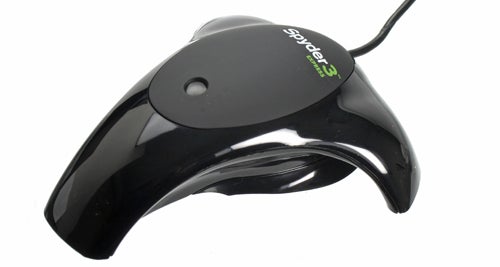
Verdict
Key Specifications
- Review Price: £72.99
Even professional-grade LCD monitors, such as the superb HP DreamColor LP2480zx, can benefit a lot from colour calibration. Especially since the switch from CRT to LCD for monitors, colour calibration is crucial to anyone who is half-serious about imaging or graphics, and the only way to get the best calibration is with an external device known as a colorimeter. 
Datacolor specialises in products for the calibration of most screen types, from professional monitors to TVs, and with many colorimeter sets costing well over £100 its Spyder3 Express comes in at a surprisingly affordable £73. As you would expect, this represents the base of its Spyder3 line, which also includes Pro (around £100), Elite (generally about £130), Print and TV models. 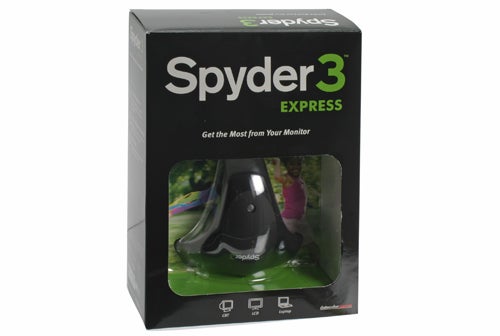
In terms of hardware, the Express gets you the same basic Spyder3 measurement device as the Pro and Elite but differs in what it allows you to adjust, some extra hardware and the included software. For example, the Express offers no gamma choices and very limited colour temperature choices (two compared with the Pro’s four and Elite’s unlimited options), and lacks the multiple display calibration, embedded ambient light sensor, desktop stand and software printer profiling of its peers (additionally the Elite offers custom luminance control, front projector calibration, custom targets such as NTSC, PAL and Cineon, and a whole host of other extras).
Datacolor’s Spyder3 Express comes neatly packaged with the device visible beneath clear plastic. In the box you’ll find a handy quick-start guide, monitor cleaning cloth, software CD, attachable suction cup and of course the colorimeter itself. 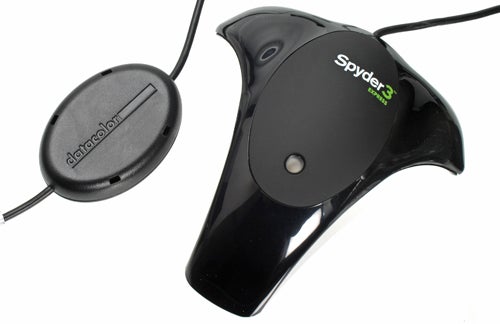
This is a very attractive-looking and well-built device, weighing in at a light 50 grams and clothed in a mixture of piano black and black rubber with a small blue LED which flashes when the Spyder3 is active. Before you connect it though, you’ll need to install the included software, which is compatible with both Windows and MacOS and can run on specifications as lowly as those of a netbook. Installation is relatively painless, but does require you to both enter a serial and subsequently record another serial number that is generated by the program and required for future installations.
Once everything is installed you can hook up the colorimeter to a USB port and you’re ready to go. At 1.75m, its USB cable is long enough to cover most situations. You can place the device on the monitor’s surface using either the suction-cup (handiest when dealing with CRTs and glass-fronted LCDs) or use the moveable counterweight on the cable to balance the meter in front of your monitor (it helps to tilt the screen slightly backwards when doing this). It’s worth noting though that the counterweight grips the cable a little too tightly making it difficult to move, something Datacolor might wish to change on future iterations.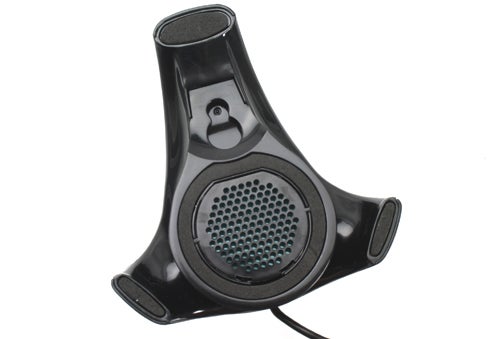
The calibration/profiling process really is as simple as it gets. You need to reset your monitor to factory defaults (which should include a colour temperature of 6,500K) and a “comfortable” brightness level. Once you start up Spyder3Express 4.0 it shows you the outline of where to place the colorimeter – don’t worry, felt pads protect against scratching the monitor’s surface – and then it’s simply a case of pressing “next”. The calibration itself is fully automatic and took just a few seconds over five minutes to complete (Datacolour claims five and 2.5 minutes for initial calibration and recalibration respectively). You’re then presented with SpyderProof, which shows you a selection of images and allows you to switch between calibrated and uncalibrated views of them. 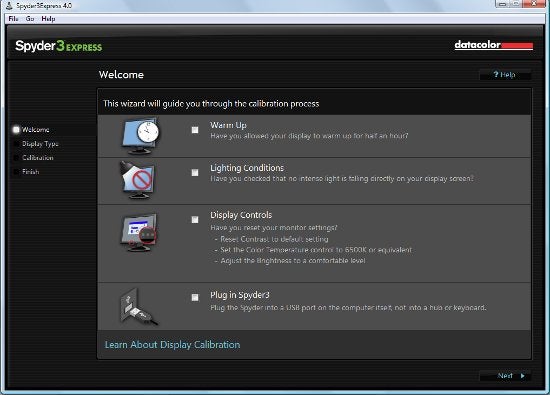
Finally you’re given the location of the .icm profile Spyder3Express 4.0 has created after the whole process is finished, which allows you to rename or copy it. Overall, the system is almost as easy to use as the box suggests and shouldn’t pose a challenge for anyone who knows how to use a mouse. 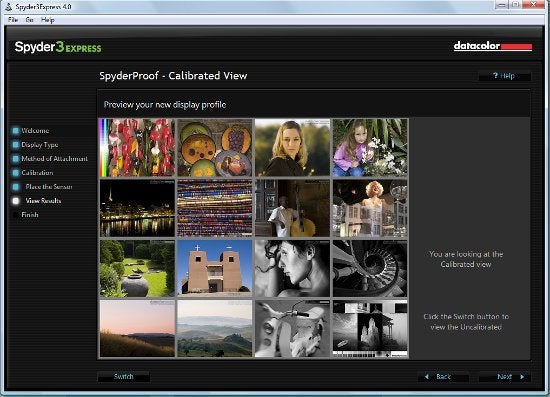
But what about the results? First we tested it with a decent but old ViewSonic monitor based on a TN panel. After automatic calibration we could see more detail in our test image, tones were closer to what they were supposed to be (originally the image was created on a high-end monitor) and colour gradations were more obvious, while dark detailing also increased. This did come at the cost of white purity, but in this case was a more than worthwhile trade-off for colour-critical work – and those who want and can afford a colorimeter would probably buy a better monitor to begin with.
Next we switched to a Dell UltraSharp 2408WFP, which uses a high-quality S-PVA panel. Here the changes were less dramatic and subjectively, we actually preferred the uncalibrated settings as white was again given a slightly ‘warmer’ tone without obviously noticeable benefits compared to a manual calibration.
Surprisingly, the uncalibrated settings also came closer to our printer’s default result, which is where the Express’ lack of additional printer calibration as found in the higher-end Spyder3 models really starts to show. Of course colour accuracy is not subjective though, so the post-calibration results are almost guaranteed to be better than what you started off with. Other monitors tested also showed obvious improvements regardless of panel type. 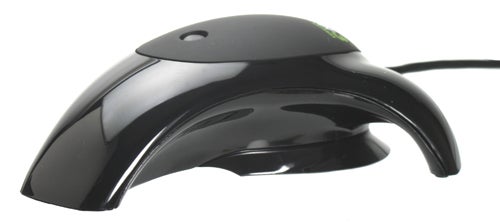
Overall then, it can’t be denied that for the majority of users who don’t know enough to manually calibrate their screens with a colorimeter yet want the accuracy that using one gives, the Spyder3 Express does an excellent job. It’s easy as pie to set up and use and will benefit anyone, not just image enthusiasts or photographers. Depending on how well your display was set up to begin with, you’ll notice a marked difference in games and films as well.
At £73 the Spyder3 Express also offers decent value. However, we can’t help but feel that unless you’re on an incredibly strict budget, the extra £30 for the next step up Spyder3 Pro makes its little cousin utterly redundant. Not only does the Pro offer a wealth of extra software options, profiles and settings, but you also get more advanced hardware, including the desktop mount and ambient light sensor (which can intelligently differentiate between actual consistent light changes compared to flash or shadow effects). If you use more than one monitor or a laptop/monitor combo, you’ll also need the Pro or Elite as the Express can’t handle multiple monitors. 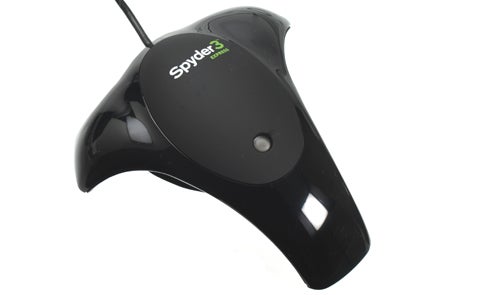
Extra flexibility extends beyond the included feature set too: as they share identical hardware, the Pro can be turned into an Elite with a simple software upgrade, and either model can be used for calibrating your TV by purchasing the Spyder3TV software. If you went for the Express, however, you’re stuck with what you’ve got. To top it all the higher-end models come with a two-year warranty compared to one year for the Express. Enough said.
Verdict
If you want one of the easiest colorimeters on the market and are on a strict budget Datacolor’s Spyder3 Express delivers, but anyone who can afford the extra £30 should definitely plump for the Spyder3 Pro as it offers more advanced hardware and a ridiculous amount of genuinely useful extra features for this relatively minor additional cost.
Trusted Score
Score in detail
-
Value 7

